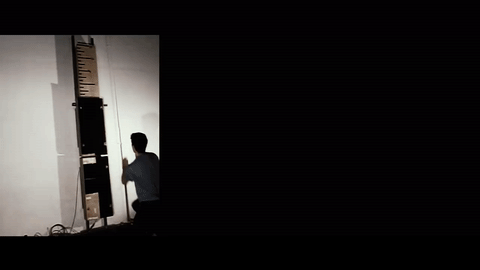PREFACE: In 2015, we partnered with the biomechanics lab at the University of Colorado at Boulder to deconstruct the vertical wall run technique. Wall runs by 20 parkour coaches and athletes from various APEX schools were analyzed using wall-mounted force plates and high-speed cameras set up at APEX Boulder. Special thanks to Amos Rendao, Dr. Rodger Kram, Peter Lawson, Bryant Pham, and all the APEX athletes and coaches who took part in the study. — Ryan Ford
Abstract
by Peter Lawson
In this study of the Parkour wall-run technique, we investigated the foot/hand forces applied during the vertical wall-run, the changes in height and vertical velocity throughout the maneuver, and the height contributions gained from the ground step versus the wall step(s). For this study, we recruited 10 advanced-level Parkour runners (the “pros”) and 10 novice-level Parkour runners (the “joes”). Each subject ran 6-10 trials up the wall, attempting to attain the maximum height possible. From our data results we were able to compute the runners CoM height and the runners CoM vertical velocities throughout the wall-run maneuver, track the calculated values of each trial in terms of both time and runner trajectory, and then make comparisons of the height contribution of the vertical jump impulse off of the ground and the vertical impulse exerted on the wall. From these results, we observed that the runners counteracted their downward gravitational acceleration by applying a vertical frictional force on the wall, and the runners were able to effectively achieve a final peak height that was approximately 1.5 times greater than had they jumped without using the wall.
Thesis Defended
Spring 2015
Document Type
Thesis
Type of Thesis
Departmental Honors
Department
Integrative Physiology
First Advisor
Dr. Rodger Kram
Second Advisor
Dr. David Sherwood
Third Advisor
Prof. Stephen Dinauer
Recommended Citation
Lawson, Peter, “Biomechanics of Parkour: The Vertical Wall-Run Technique” (2015). Undergraduate Honors Theses. 879.
http://scholar.colorado.edu/honr_theses/879
Acknowledgements
I would like to recognize Ryan Ford, Amos Rendao, and the rest of the ParkourEDU & APEX teams; it was their Parkour expertise and generosity that made this project possible. I would like to recognize Bryant Pham and Dr. Rodger Kram for their knowledge and mentorship that helped guide me through every step of this project.
Ryan Ford is the author of Parkour Strength Training and founder of ParkourEDU & APEX School of Movement.


Hello. My name is Lim Dong Geon, the leader of the Korea Parkour Association(KPA). I wonder is it ok for me to translate this research and upload it on our website. Of course we’ll notice the author of this research and original link. Hope you reply to me. Thank you.
Please feel free to translate/share/repost as you see fit. All we ask is that you link and credit us in a fair, prominent way. And send us a link when it’s live 🙂
Thank you for your permission. We finally finished translation!!
You can download it from the link below.
-Translation Download Link-
https://drive.google.com/open?id=1IVSVSBjbQEgPinD8X0FLlg8e-Ldiiqxk
Also these are the links where we upload it.
1.https://www.facebook.com/pk.korea/?ref=bookmarks
2.https://koreaparkour.modoo.at/?link=55nb0vw6&messageNo=1&mode=view
Again, really thank you for your permission. Hope you like it.